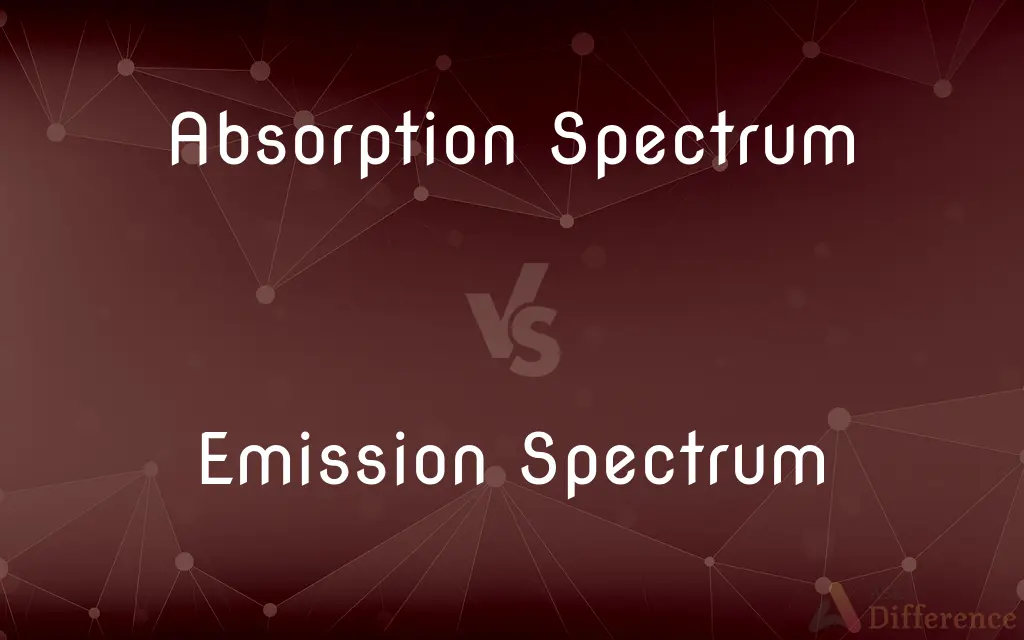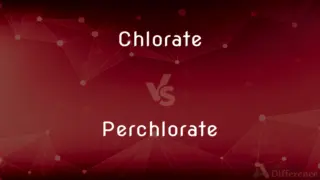Absorption Spectrum vs. Emission Spectrum — What's the Difference?
By Tayyaba Rehman — Published on November 10, 2023
Absorption Spectrum is a pattern of wavelengths absorbed by a substance. Emission Spectrum is a pattern of wavelengths emitted by an excited substance.

Difference Between Absorption Spectrum and Emission Spectrum
Table of Contents
ADVERTISEMENT
Key Differences
An Absorption Spectrum is a visual representation of wavelengths of light that a substance absorbs. When light passes through a substance, certain wavelengths are taken in by its atoms or molecules, leading to the creation of this spectrum. On the other hand, an Emission Spectrum depicts the wavelengths of light that a substance emits. This occurs when an excited atom or molecule returns to its ground state, releasing energy in the form of light.
In the Absorption Spectrum, dark lines or bands represent the specific wavelengths that have been absorbed by the substance, creating a unique pattern. Conversely, in the Emission Spectrum, bright lines or bands signify the wavelengths that are emitted. Each substance possesses a distinctive emission and absorption spectrum, making them vital tools for identification.
When observing an Absorption Spectrum, one is essentially looking at the wavelengths that are "missing" or absorbed from the continuous spectrum of light that passed through the substance. The Emission Spectrum, in contrast, is seen when examining the specific wavelengths emitted by a substance after it has been excited, typically by heating or through electrical discharge.
A key utility of the Absorption Spectrum is in fields like astronomy, where it assists in identifying the composition of distant stars by analyzing the wavelengths they absorb. The Emission Spectrum, on the other hand, finds extensive use in labs, where it aids in determining the elements or compounds present in a sample based on the light they emit.
Comparison Chart
Nature
Shows wavelengths absorbed by a substance.
Depicts wavelengths emitted by a substance.
ADVERTISEMENT
Appearance
Dark lines on a bright background.
Bright lines on a dark background.
Cause
Light passing through a substance.
Excited atoms or molecules returning to their ground state.
Use
Identifying substances by absorbed wavelengths.
Determining elements or compounds based on emitted light.
Examples of Applications
Analyzing the composition of distant stars.
Determining elements in labs.
Compare with Definitions
Absorption Spectrum
Dark lines against a continuous spectrum indicating absorbed wavelengths.
By studying the Absorption Spectrum, we discerned the material's components.
Emission Spectrum
A pattern showing which light wavelengths a substance releases.
The Emission Spectrum revealed the element's presence in the sample.
Absorption Spectrum
A pattern showing which light wavelengths a substance takes in.
The Absorption Spectrum of chlorophyll reveals its vital role in photosynthesis.
Emission Spectrum
A diagnostic tool showcasing the wavelengths a substance emits upon returning to its ground state.
By analyzing the Emission Spectrum, we determined the gas's composition.
Absorption Spectrum
The graphical representation of absorbed light wavelengths.
This star's Absorption Spectrum indicates the presence of helium.
Emission Spectrum
The graphical representation of emitted light wavelengths.
The gas's Emission Spectrum glowed with distinctive bright lines.
Absorption Spectrum
A unique signature of wavelengths absorbed by molecules or atoms.
Each element has a distinctive Absorption Spectrum that aids in its identification.
Emission Spectrum
A unique signature of wavelengths emitted by molecules or atoms when excited.
Hydrogen's Emission Spectrum is utilized to identify its presence in stars.
Absorption Spectrum
A diagnostic tool showcasing the wavelengths a substance prevents from passing through.
The Absorption Spectrum helped identify the contaminants in the sample.
Emission Spectrum
Bright lines on a dark background indicating emitted wavelengths.
The neon sign displayed colors corresponding to neon's Emission Spectrum.
Common Curiosities
Which spectrum results from atoms returning to their ground state?
The Emission Spectrum is the result of atoms returning to their ground state.
How is the Emission Spectrum generated?
An Emission Spectrum is produced when excited atoms or molecules emit specific wavelengths of light.
Can the Absorption Spectrum be used for element identification?
Yes, the Absorption Spectrum can help identify elements based on their unique absorption patterns.
What represents absorbed wavelengths in the Absorption Spectrum?
In the Absorption Spectrum, absorbed wavelengths appear as dark lines or bands.
How does the Emission Spectrum differ in appearance from the Absorption Spectrum?
The Emission Spectrum has bright lines on a dark background, while the Absorption Spectrum shows dark lines on a bright background.
Can two substances have identical Absorption and Emission Spectra?
No, each substance has a unique Absorption Spectrum and Emission Spectrum.
What is an Absorption Spectrum?
An Absorption Spectrum displays the wavelengths of light absorbed by a substance.
Where is the Emission Spectrum typically observed in a lab setting?
In labs, the Emission Spectrum is often seen when a sample is heated or subjected to electrical discharge.
Is the Absorption Spectrum always the opposite of the Emission Spectrum?
Not necessarily, though there's a relation; the Absorption Spectrum displays absorbed wavelengths, while the Emission Spectrum shows emitted ones.
In what context is the Absorption Spectrum often used in astronomy?
The Absorption Spectrum assists in identifying the composition of distant celestial bodies like stars.
What causes the bright lines in the Emission Spectrum?
The bright lines in the Emission Spectrum arise from specific wavelengths emitted by excited substances.
Why are the lines in the Emission Spectrum bright?
In the Emission Spectrum, bright lines result from the release of energy as light at specific wavelengths.
How does the Absorption Spectrum differ from a continuous spectrum?
A continuous spectrum shows all wavelengths, while the Absorption Spectrum has dark lines where specific wavelengths have been absorbed.
Can the Emission Spectrum help determine the temperature of stars?
Yes, the Emission Spectrum can provide clues about the temperature and composition of stars.
How is the Absorption Spectrum useful in photosynthesis research?
The Absorption Spectrum of chlorophyll and other pigments reveals which wavelengths they absorb, aiding in understanding photosynthesis.
Share Your Discovery

Previous Comparison
Chlorate vs. Perchlorate
Next Comparison
Absolute Magnitude vs. Apparent MagnitudeAuthor Spotlight
Written by
Tayyaba RehmanTayyaba Rehman is a distinguished writer, currently serving as a primary contributor to askdifference.com. As a researcher in semantics and etymology, Tayyaba's passion for the complexity of languages and their distinctions has found a perfect home on the platform. Tayyaba delves into the intricacies of language, distinguishing between commonly confused words and phrases, thereby providing clarity for readers worldwide.












































